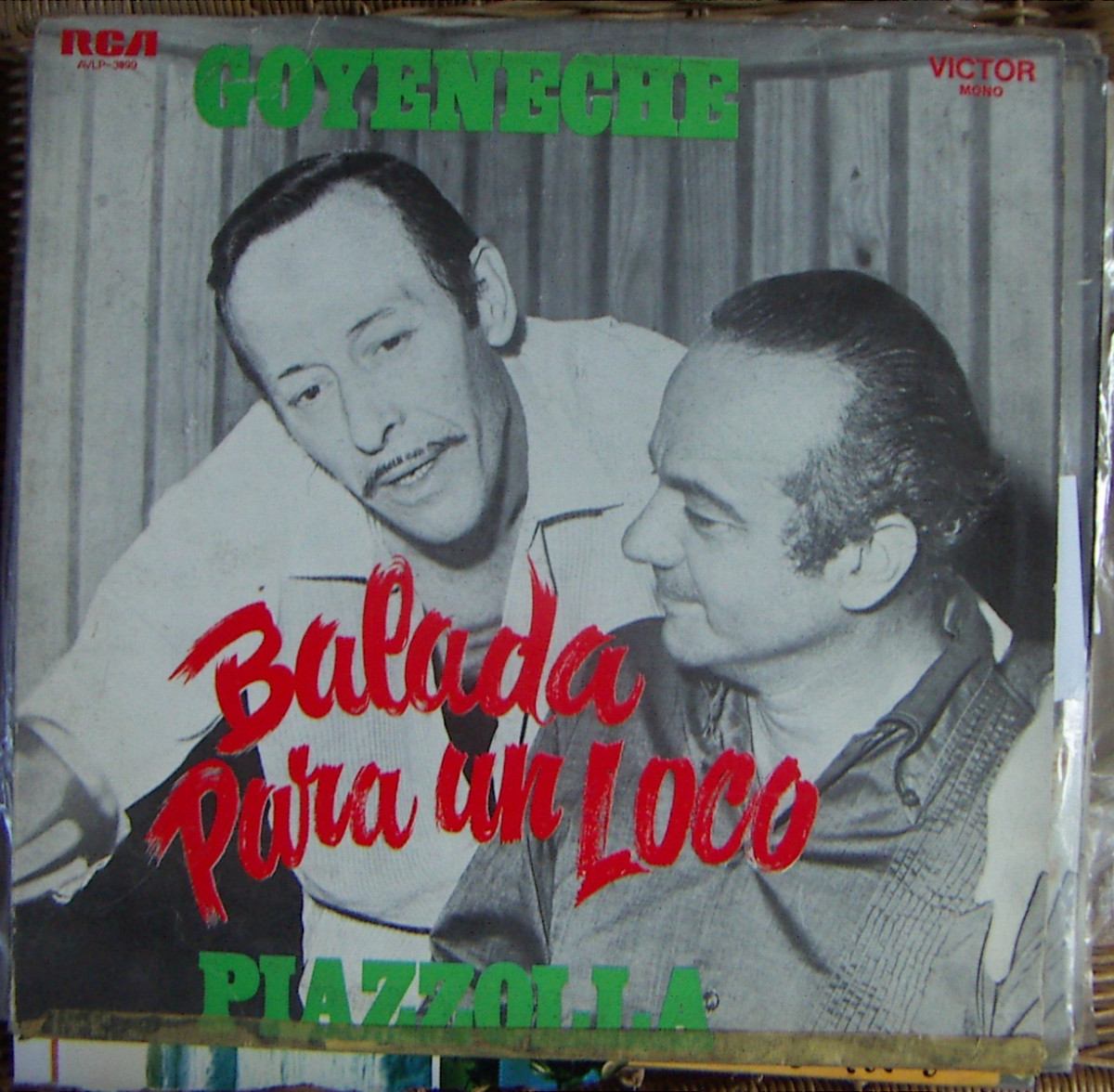Tango combines African sounds brought over to South America by slaves along with the traditions of European immigrants and criollos (South American natives of Spanish descent). It has always been, then, a blend of diverse heritages and cultures. But, after emerging in the late 19th and early 20th centuries, it eventually became established as a definable genre with boundaries and rules, and many of its proponents became unwilling to accept radical challenges to the formula. When Astor Piazzolla and Horacio Ferrer released “Balada para un loco” (Ballad for a madman) in 1969, there was a huge popular and critical uproar. Suddenly, everyone in Argentina was asking the same question: “Is this tango?”
The song premiered on November of that year, in the Buenos Aires Festival of Song and Dance. Despite strong competition from hundreds of contestants, “Balada para un loco” seemed poised to win the top prize. That is, until the festival organizers retooled the voting process so that a more traditional song would win instead: “Hasta el último tren,” by Julio Ahumada and Julio Camilloni. In and of itself, it was not an unworthy winner, but it was definitely old-fashioned. Today, it’s mostly remembered as the song that beat "Ballad for a madman.” At any rate, Piazzolla and Ferrer, along with their singer of choice Amelita Baltar, barely had time to regret their loss: “Balada para un loco” became an overnight sensation, selling more than 200 thousand copies in a week and turning into an instant classic. Since then, modern brands of tango have become widely popular, and contemporary groups like Gotan Project and Bajofondo Tango Club, with their tango fusion or electronic tango, owe much to Piazzolla and Ferrer.
"When Astor Piazzolla and Horacio Ferrer released “Balada para un loco” in 1969, everyone in Argentina was asking the same question: 'Is this tango?'"
Of course, neither artist was exactly known for sticking to the mold. Piazzolla, who wrote the music, had been recognized as a rebel long before 1969. Already in the early 50s, he was called “the enemy of tango,” to which Piazzolla replied, in a 1954 interview: “Yes, I’m the enemy of tango, but tango as they (i.e. the old guard) understand it.” He emigrated to New York as a child, where he listened to American jazz, and as an adult he studied classical music in France, so it was to be expected that he would combine tango with these other musical genres. Ferrer, who penned the lyrics, was also no ordinary writer, and his imagery is strange and surreal. Both of them would go on to successful careers in the 70s and beyond, especially Piazzolla.

“Balada para un loco” starts with a long recited passage. A woman goes for a walk on the streets of Buenos Aires and finds an eccentric man: a “strange mix between a hobo and the first patrolman on the trip to Venus.” In Argentina, specifically in Buenos Aires, the homeless are often known as “linyeras,” and that’s the word used by the narrator, who also calls the patrolman a “polizonte,” which is not actually a common Argentine word and is sometimes used incorrectly as a substitute for “polizón,” which means “stowaway.” As the sung portion begins, the narrator no longer describes her own experiences but rather the words being directed at her by the eccentric man. “I know I’m mad, mad, mad,” he screams. “Can’t you see the moon rolling down Callao?” The word for “mad” employed here is “piantao,” which is old Argentine slang for “a little bit crazy.” Elsewhere, the madman confesses: “I gaze at Buenos Aires from a sparrow’s nest, and from there I saw you looking so sad…” In this case, “you” is the female narrator, who listens to the man’s words of love. Callao is one of the main avenues in Buenos Aires, which – along with its continuation, Entre Ríos – connects the northern and southern sections of the city, and crosses another street mentioned in the song, Arenales, which is located in the wealthy Recoleta neighborhood.
"'Balada para un loco' is now a classic tango, its critics be damned."
Yet another street referenced in the song is Vieytes, which leads to Buenos Aires’ best-known psychiatric hospital, the Borda. Ferrer imagines the lovers in “Balada para un loco” being cheered onward by the hospital patients, “those fools who invented Love,” while the narrator calls her new eccentric boyfriend a “madman, my madman.” So do the lyrics play around with the idea of being crazily in love and enjoying the “magical insanity of living again.” The narrator feels alive and reenergized, while her partner asks of her: “Love me like this: mad, mad, mad.” She seems to agree: “He’s crazy and I’m crazy. Crazy, crazy, crazy!” Both a song about how love makes you nuts and about how it requires you to accept your loved one’s eccentricities, “Balada para un loco” is now a classic tango, its critics be damned.

Lyrics:
(Recited)
Las tardecitas de Buenos Aires tienen ese qué sé yo, ¿viste? Salís de tu casa, por Arenales. Lo de siempre: en la calle y en mi... Cuando, de repente, de atrás de ese árbol, se aparece él. Mezcla rara de penúltimo linyera y de primer polizonte en el viaje a Venus: medio melón en la cabeza, las rayas de la camisa pintadas en la piel, dos medias suelas clavadas en los pies, y una banderita de taxi libre levantada en cada mano. ¡Ja, ja! Parece que sólo yo lo veo. Porque él pasa entre la gente, y los maniquíes le guiñan; los semáforos le dan tres luces celestes, y las naranjas del frutero de la esquina le tiran azahares. Y así, medio bailando y medio volando, se saca el melón, me saluda, me regala una banderita, y me dice...
(Sung)
Ya sé que estoy piantao, piantao, piantao...
No ves que va la luna rodando por Callao;
que un corso de astronautas y niños, con un vals,
me baila alrededor... ¡Bailá! ¡Vení! ¡Volá!
Ya sé que estoy piantao, piantao, piantao...
Yo miro a Buenos Aires del nido de un gorrión;
y a vos te vi tan triste... ¡Vení! ¡Volá! ¡Sentí!...
el loco berretín que tengo para vos:
¡Loco! ¡Loco! ¡Loco!
Cuando anochezca en tu porteña soledad,
por la ribera de tu sábana vendré
con un poema y un trombón
a desvelarte el corazón.
¡Loco! ¡Loco! ¡Loco!
Como un acróbata demente saltaré,
sobre el abismo de tu escote hasta sentir
que enloquecí tu corazón de libertad...
¡Ya vas a ver!
(Recited)
Y, así diciendo, El loco me convida
A andar en su ilusión super-sport,
y vamos a correr por las cornisas
¡con una golondrina en el motor!
De Vieytes nos aplauden: "¡Viva! ¡Viva!",
los locos que inventaron el Amor;
y un ángel y un soldado y una niña
nos dan un valsecito bailador.
Nos sale a saludar la gente linda...
Y El loco, loco mío, ¡qué sé yo!,
provoca campanarios con su risa,
y al fin, me mira, y canta a media voz:
(Sung)
Quereme así, piantao, piantao, piantao...
Trepáte a esta ternura de locos que hay en mí,
ponete esta peluca de alondras, ¡y volá!
¡Volá conmigo ya! ¡Vení, volá, vení!
Quereme así, piantao, piantao, piantao...
Abrite los amores que vamos a intentar
la mágica locura total de revivir...
¡Vení, volá, vení! ¡Trai-lai-la-larará!
(Screamed)
¡Viva! ¡Viva! ¡Viva!
¡Loco él y loca yo!
¡Locos! ¡Locos! ¡Locos!
¡Loco él y loca yo!




